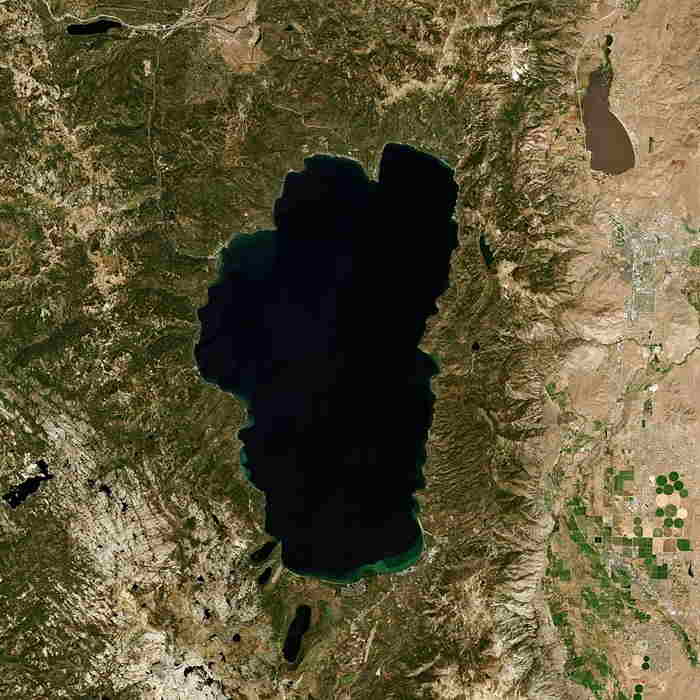

Lake Superior is the largest of the five Great Lakes of North America in terms of surface area, measuring at 31,700 square miles. It is the second largest freshwater lake in the world, exceeded in size only by Russia's Lake Baikal. It has a volume of 12088 cubic km. The lake is located along the Canada-United States border and is shared by the provinces of Ontario and Manitoba in Canada, as well as the states of Minnesota, Wisconsin, and Michigan in the United States. Lake Superior has a maximum depth of nearly 406 meters and an average depth of around 147 meters. Its deepest point is located near Caribou Island in Ontario, at 406 meters. Due to its vast size and depth, Lake Superior is known for its cold, fresh waters. It holds more than 2,900 cubic kilometers of water, making it the largest freshwater lake by volume in the world.

Lake Michigan is only one of the five Great Lakes that is entirely located in the United States. It is located in the northern Midwest, in the states of Illinois, Indiana, Michigan, and Wisconsin. Lake Michigan has a volume of 4918 cubic km. The lake has a surface area of approximately 22,404 square miles. It is 307 miles long, 118 miles wide, and 925 feet deep at its deepest point.

Lake Huron is located between the Canadian province of Ontario to the north, and the US state of Michigan to the south. It has a volume of 3543 cubic km. At 23,007 square miles, Lake Huron is the fifth largest freshwater lake in the world, and the third largest in the Great Lakes system. The lake is considered to be hydrologically part of the North Atlantic Ocean, since it is connected to Lake Michigan through the Straits of Mackinac. The surface area of Lake Huron is slightly larger than the combined area of the U.S. states of West Virginia, Maryland, and Delaware. The western end of Lake Huron is bounded by Saginaw Bay, the eastern end is bounded by Georgian Bay, and the northern shore is bounded by Manitoulin Island. The lake is about 206 miles long and 183 miles wide at its widest point. The average depth of the lake is 195 feet, and the maximum depth is 750 feet.

Lake Ontario is located on the international border between Canada and the United States.It has a voulume of 1638 cubic km. At its deepest point, Lake Ontario reaches a depth of 802 feet. Lake Ontario has a total surface area of 7,340 square miles (18,960 square kilometers). It is the smallest of the Great Lakes in terms of surface area, but the fourth largest in terms of volume.

Lake Erie is the fourth largest of the five Great Lakes, with a surface area of about 9,910 square miles. The lake has a volume of 484 cubic km. It is the shallowest of the Great Lakes and has an average depth of just 210 feet. The lake is bounded by the Canadian province of Ontario to the north, the US states of Ohio, Pennsylvania, and New York to the south, and the US state of Michigan to the west.

Lake Tahoe is a breathtaking freshwater lake nestled in the Sierra Nevada mountain range, straddling the border of California and Nevada in the United States. Renowned for its stunning clarity and azure-blue waters, Lake Tahoe is the second-deepest lake in North America and the tenth deepest in the world, with a maximum depth of approximately 1,645 feet (501 meters). Spanning an impressive surface area of about 191 square miles (495 square kilometers), Lake Tahoe ranks as one of the largest alpine lakes globally. The lake's volume is estimated to be around 150 cubic kilometers.

Iliamna Lake, located in southwestern Alaska, is the largest lake in the state. Nestled within the stunning Alaska Range, Iliamna Lake spans an expansive area of approximately 1,012 square miles (2,620 square kilometers). It stands out not only for its size but also for being the largest freshwater lake in Alaska. With a maximum depth of around 988 feet (301 meters), Iliamna Lake plunges into impressive depths, contributing to its significance in the region. The lake's volume is estimated to be substantial, reflecting its vast size and depth. The lake has a volume of 116 cubic km.

Lake Pend Oreille, situated in the northern panhandle of Idaho, is a picturesque glacial lake known for its scenic beauty and impressive dimensions. With a surface area spanning approximately 148 square miles (383 square kilometers), Lake Pend Oreille is the largest lake in Idaho and the fifth deepest in the United States, reaching depths of around 1,158 feet (353 meters). The lake has a volume of 54.2 cubic km.

Becharof Lake, located in the southwestern part of Alaska's Alaska Peninsula, is a notable freshwater lake known for its size, depth, and pristine wilderness surroundings. The lake has a maximum depth of 302 ft (92 m) and a volume of 44 cubic km. Becharof Lake has a surface area of 453 sq miles (1,170 square km).

Lake Clark, situated within the Lake Clark National Park and Preserve in southern Alaska, is a stunning freshwater lake surrounded by snow-capped mountains, dense forests, and pristine wilderness. The lake is about 64 km long and about 8 km wide. It has a volume of 31.7 cubic km and a maximum depth of 1,056 ft (322 m).